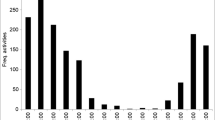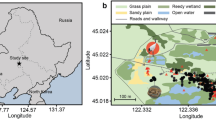Abstract
The behavioral repertoire and environmental feature needs for thermoregulatory comfort have not been reported in the literature for large captive exotics. An observational study was done to investigate the behavioral repertoire of tigers via continuous observation, while focusing on thermoregulatory behavior, in order to examine behavioral and thermoregulatory needs of these animals, and inform microclimatic landscape design for thermal comfort. Nine Bengal tigers (n = 6 females, n = 3 males) were observed in June 2012, and behavior data were recorded every minute, while thermal images of each individual, wind speed, ambient temperature, and relative humidity were recorded every 15 min. Descriptive statistics were used to analyze the data due to the observatory nature of the study. All tigers spent on average over 45% of the time lying down, less than 19% of the time in direct sunlight and over 20% of their time in the shade. Males did more panting (25.6%) than females (15.1%). There was more individual variation in water and cave usage, compared with shade use and lying behaviors, which could be related to social pressures or basic individual preferences. In summary, shade is a very valuable thermoregulatory resource for tigers. Adding more shade structures to increase thermal comfort and increase activity in these cats (around 10% on average active behaviors) by adding to the space available in the shaded areas.





Similar content being viewed by others
References
Anderson SD, Bradford BJ, Harner JP, Tucker CB, Choi CY, Allen JD, Hall LW, Bungruang S, Collier RJ, Smith JF (2013) Effects of adjustable and stationary fans with misters on core body temperature and lying of lactating dairy cows in semiarid climate. J Dairy Sci 96:4738–4475
Brown RD, Gillespie TJ (1995) Microclimatic landscape design: creating thermal comfort and energy efficiency. John Wiley and Sons, Inc, New York
Cabanac M (1972) Temperature regulation. Annual review of physiology. Annu Rev Physiol 37:415–439
Cannas S, Frank D, Minero M, Aspesi A, Benedetti R, Palestrini C (2014) Video analysis of dogs suffering from anxiety when left home alone and treated with clomipramine. J Vet Med 9:50–57
Cossins AR, Bowler K (1987) Temperature biology of animals. Chapman and Hall, London
Creel S (2001) Social dominance and stress hormones. Trends Ecol Evol 16(9):491–497
Godbout M, Palestrini C, Beauchamp G, Frank D (2007) Puppy behaviour at the veterinary clinic: a pilot study. J Vet Behav 2:126–135
Google earth V 7.1.7.2606 (2016) Busch Gardens, Tampa, Florida. 28°02’ 18.94” N 82°25’ 27, 29’ W, Eye alt 282 feet. Google earth 2016. http://www.earth.google.com. Accessed 5 Nov 2016
Hediger H (1950) Wild animals in captivity. Butterworths Scientific Publications, London
Hosey G, Melfi V, Pankhurst S (2009) Zoo animals: behavior, management, and welfare. Oxford University Press, New York
Hutchinson JCD, Brown GB (1969) Penetrance of cattle coats by radiation. J Appl Physiol 26:454–464
Langman VA, Rowe M, Forthman D, Whitton B, Langman N, Roberts T, Hustion K, Boling C, Maloney D (1996) Thermal assessment of zoological exhibits I: lion enclosure at the Audubon Zoo. Zoo Biol 15:403–411
Litchfield C, Dorrian J, Davis J, Lushington K, Dawson D (2011) Lessons in primate heat tolerance: a commentary based on the “human zoo” experience. J Appl Anim Welf Sci 14:162–169
Martin P, Bateson P (2007) Measuring behaviour: an introductory guide 3rd Ed. Cambridge University Press, United Kingdom
Moesta A, Crowell-Davis S (2011) Intercat aggression - general considerations, prevention and treatment. PubMed 39(2):97–104
Smith Y, Kok OB (2006a) Loin exposure as a means of complementing thermoregulation in Kalahari lions (Panthera leo Linnaeus, 1958). Pak J Biol Sci 9(11):2168–2172
Smith Y, Kok OB (2006b) A suggested thermoneutral zone for African lions (Panthera leo Linnaeus, 1758) in the southwestern Kalahari, Namibia. Pak J Biol Sci 9(13):2535–2537
Stanton LA, Sullivan MS, Fazio JM (2015) A standardized ethogram for the felidae: a tool for behavioural researchers. Appl Anim Behav Sci 173:3–16. Retrieved from, https://www.researchgate.net/publication/275060791_A_Standardized_Ethogram_for_the_Felidae_A_Tool_for_Behavioral_Researchers. Accessed 8 Nov 2016
Titto CG, Negrãgo JA, Canaes EAL, Canes TDS, Titto RM, Pereira AMF (2013) Effects of an evaporative cooling system on plasma cortisol, IGF0I, and milk production in dairy cows in a tropical environment. Int J Biometeorol 57:299–306
Valtorta SE, Leva PE, Gallardo MR (1997) Evaluation of different shades to improve dairy cattle well-being in Argentina. Int J Biometeorol 41:65–67
Weather Underground, (2016) Tampa International Airport. History search. Retrieved on November 3rd, 2016, from https://www.wunderground.com/history/airport/KTPA/2012/6/5/DailyHistory. html?req_city=&req_state=&req_statename=&reqdb.zip=&reqdb.magic=&reqdb.wmo=
Willmer P, Stone G and Johnston I. 2006. Environmental physiology of animals 2nd Ed. Blackwell Science Ltd 211–215
Young T, Finegan E, Brown RD (2013) Effects of summer microclimates on behavior of lions and tigers in zoos. Int J Biometeorol 57:381–390
Acknowledgments
The authors would like to thank the Department of Animal Biosciences at the University of Guelph, Busch Gardens, Tampa, FL, and the tiger house staff of Jungala at Busch Gardens for facilitating the research. We also acknowledge the technical contribution of several undergraduate and other behavior and weather data recorders that made this work possible.
Funding
A portion of this work was funded by the Ontario Graduate Scholarship grant and the University of Guelph, Animal Biosciences department.
Author information
Authors and Affiliations
Corresponding author
Ethics declarations
All research was approved by the University of Guelph’s Animal Care Committee and the Research Review Committee at Busch Gardens, Tampa, FL.
Electronic supplementary material
Online Resource 1
Average Ambient Temperature (°C) and average ambient vapor pressure (kPa), for all groups (G1, G2, G3) and days (D1, D2, D3) of observation. (PDF 255 kb)
Rights and permissions
About this article
Cite this article
Stryker, J.A., Atkinson, J.L., Brown, R.D. et al. Behavioral repertoire assessment of Bengal tigers (Panthera tigris) with focus on thermoregulatory behavior. Int J Biometeorol 63, 1369–1379 (2019). https://doi.org/10.1007/s00484-019-01753-7
Received:
Revised:
Accepted:
Published:
Issue Date:
DOI: https://doi.org/10.1007/s00484-019-01753-7




